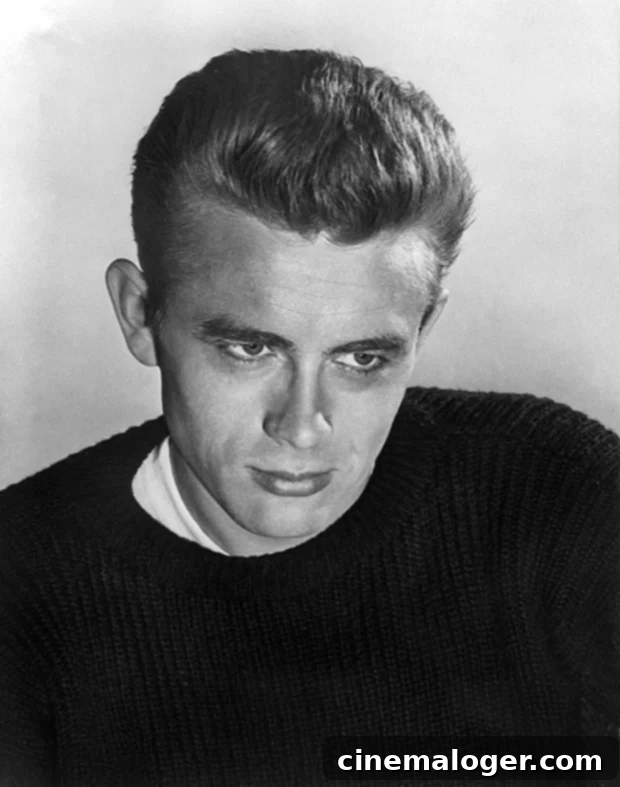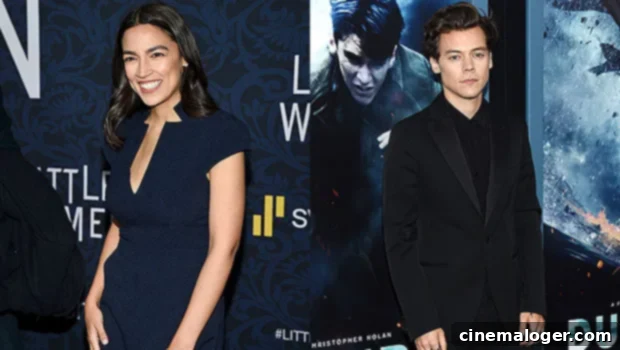AOC Champions Harry Styles’ Iconic Vogue Cover: Redefining Masculinity and Fashion’s Cultural Impact
In a moment that transcended fashion commentary to become a broader cultural discussion, Congresswoman Alexandria Ocasio-Cortez, widely known as AOC, offered a resounding endorsement of Harry Styles’ groundbreaking December 2020 *Vogue* cover. The image, which featured the acclaimed singer in a stunning Gucci gown paired with a sharp jacket, sparked immediate conversation, both appreciative and critical. When asked for her opinion on the controversial ensemble via her Instagram Story, AOC, 31, didn’t hold back, declaring the look “wonderful” and, intriguingly, drawing parallels to the legendary late 1950s actor, James Dean.
“It looks wonderful. The masculine and feminine elements are balanced beautifully – the hair and jacket styling give me James Dean vibes too,” Ocasio-Cortez penned in her initial reaction. This simple yet profound statement immediately positioned her as a vocal supporter of artistic expression and challenging gender norms in fashion. Her comparison of Styles, 26, to James Dean — an icon synonymous with rebellious cool and a certain understated masculinity — was particularly insightful. Dean, known for his timeless style and defiant attitude in films like *Rebel Without a Cause*, embodied a raw, unconventional appeal. By linking Styles’ modern, gender-fluid fashion to Dean’s classic yet rule-breaking image, AOC suggested that true style and confidence transcend rigid definitions, echoing a spirit of individuality that remains potent across generations.
AOC + Harry Styles>>>>>>>>Candace Owens any day 💃🏽 pic.twitter.com/miWZ1m2u86
— Carly 💅🏼 (she/her) (@carlymbutton) November 22, 2020
The Heart of the Debate: Challenging Gender Norms in Fashion
While many celebrated Harry Styles’ bold choice as a stride towards gender fluidity in mainstream fashion, the *Vogue* cover also drew sharp criticism. Among the most prominent detractors was conservative political activist Candace Owens, 31, who provocatively tweeted, “There is no society that can survive without strong men. The East knows this. In the west, the steady feminization of our men at the same time that Marxism is being taught to our children is not a coincidence. It is an outright attack. Bring back manly men.” This perspective ignited a fiery debate, contrasting sharply with AOC’s more progressive outlook.
Alexandria Ocasio-Cortez, however, viewed this backlash not as a deterrent but as a crucial opportunity for introspection and growth. She eloquently articulated her philosophy, explaining, “Some people are mad at it bc some folks are very sensitive to examining and exploring gender roles in society. Perhaps for some people it provokes some anger or insecurity around masculinity/femininity/etc. If it does, then maybe that’s part of the point. Sit with that reaction and think about it, examine it, explore it, engage it, and grow with it.” This statement highlighted the deeper societal implications of Styles’ fashion choice, suggesting that the discomfort some experienced was indicative of ingrained prejudices or anxieties about shifting gender paradigms. Rather than dismissing or condemning these reactions, AOC encouraged a mindful engagement with them, urging individuals to understand the roots of their feelings.
Expanding on this idea, the Congresswoman delved into the very purpose of creative expression, particularly in a world often resistant to change. “What’s the point of creating things if they don’t make people think? Or feel or reflect? Especially as an artist or creative? Who wants to see the same thing all the time? And never explore their assumptions?” she continued. Her words underscored the vital role of art and fashion as catalysts for cultural evolution. True creativity, she argued, isn’t about reaffirming the status quo, but about pushing boundaries, questioning conventions, and ultimately, fostering a more expansive understanding of identity and self-expression. Fashion, in this context, becomes a powerful medium for societal dialogue, challenging us to look beyond superficial aesthetics to the underlying messages about who we are and who we aspire to be.
A Visual Statement: The James Dean Connection

The comparison between Harry Styles and James Dean by AOC was not merely a casual observation; it was a potent historical and cultural juxtaposition. James Dean, despite his short career, left an indelible mark on American culture, embodying a rebellious spirit that resonated deeply with the youth of his era. His signature style—denim jeans, a white t-shirt, and a leather jacket—became an enduring symbol of cool, non-conformity, and a certain masculine allure that defied the rigid conservatism of the 1950s. Dean’s appeal lay in his ability to challenge norms subtly, through his intense gaze and understated defiance, all while retaining a powerful sense of self.
By invoking Dean’s name, AOC positioned Harry Styles within a lineage of cultural figures who use their public platform to redefine what is considered acceptable or iconic. Styles, with his increasingly fluid approach to fashion—donning pearls, lace, and dresses—represents a contemporary iteration of that same rebellious spirit. He challenges the traditional strictures of menswear, much as Dean pushed against the prevailing societal expectations of his time. The “masculine and feminine elements” that AOC noted in Styles’ *Vogue* cover outfit speak to a modern sensibility where strength is found not in adhering to antiquated gender stereotypes, but in the freedom of authentic self-expression. The jacket, a traditionally masculine garment, layered over a flowing dress, creates a visual dialogue that is both daring and harmonious, an aesthetic that AOC rightly deemed “bomb.” This blend signifies a future where fashion is less about gender-coded uniforms and more about personal narrative.
Public Reception and Harry Styles’ Own Philosophy
AOC’s articulate defense of Harry Styles’ style resonated strongly across social media. Her message quickly went viral, attracting widespread appreciation from fans who saw her perspective as both insightful and validating. Tweets like “aoc talking about harry styles WE LOVE” and “Omg AOC TALKING ABOUT HARRY STYLES IS EVERYTHING” flooded timelines, reflecting a collective relief and admiration for her progressive stance. This public endorsement from a prominent political figure lent additional weight to the conversation, highlighting that fashion choices, especially those that challenge norms, are legitimate subjects of serious discussion regarding identity, societal expectations, and personal freedom. It demonstrated that cultural commentary can effectively bridge the gap between pop culture and broader socio-political discourse.
While AOC provided a thoughtful sociological analysis of the controversy, Harry Styles himself maintains a more personal and less overtly political approach to his fashion choices. In the very *Vogue* issue that sparked the debate, the British pop star opened up about his motivations, articulating a philosophy rooted in pure enjoyment and creative exploration. “There’s so much joy to be had in playing with clothes,” he gushed. “I’ve never really thought too much about what it means. It just becomes this extended part of creating something.” Styles’ words reveal an authentic desire to express himself without the burden of labels or expectations. For him, fashion is an extension of his artistry, a playful medium through which he can explore different facets of his personality and creativity. This uninhibited approach not only defines his unique aesthetic but also inspires countless others to embrace their own sartorial freedom, unconstrained by conventional gender roles or societal pressures. His joy, unburdened by external interpretations, is a powerful statement in itself.
Fashion as a Catalyst for Conversation
The confluence of Harry Styles’ bold fashion statement and Alexandria Ocasio-Cortez’s insightful commentary created a potent cultural moment, forcing a much-needed examination of gender roles and self-expression. High-profile instances like Styles’ *Vogue* cover serve as critical touchpoints in the ongoing evolution of societal norms. They challenge entrenched beliefs about masculinity and femininity, pushing boundaries not just in fashion but in the broader public consciousness. When figures like Styles, who command massive global attention, break from tradition, they normalize new forms of expression for a vast audience, especially younger generations who are already more attuned to fluid identities.
AOC’s intervention transformed what could have been a fleeting pop culture controversy into a sustained and meaningful dialogue. Her invitation to “sit with that reaction” provided a framework for constructive engagement, rather than mere dismissal of differing viewpoints. It underscored the idea that fashion, at its most impactful, is a form of non-verbal communication, capable of conveying powerful messages about individuality, societal change, and the pursuit of authenticity. This incident highlighted how celebrity influence, when thoughtfully engaged with by political and cultural commentators, can serve as a powerful engine for progress, encouraging empathy, understanding, and an openness to diverse ways of being.
Conclusion: The Enduring Message of Style and Self-Exploration
In conclusion, Harry Styles’ *Vogue* cover, featuring him in a dress, was more than just a fashion spread; it was a cultural phenomenon. Alexandria Ocasio-Cortez’s articulate defense and deeper analysis of the look elevated the conversation, moving it beyond mere aesthetic judgment to a thoughtful examination of gender roles, societal expectations, and the very purpose of creative expression. By likening Styles to a modern-day James Dean, she connected contemporary gender fluidity to a historical lineage of rebellious individualism, suggesting that challenging norms is a timeless act of self-assuredness. Styles, for his part, demonstrated that joy and creativity are paramount in personal style, offering a refreshing counter-narrative to rigid sartorial rules. The collective impact of this moment underscores the power of fashion to provoke thought, challenge assumptions, and ultimately, foster a more inclusive and understanding world where individuality is celebrated and explored with courage and curiosity.
